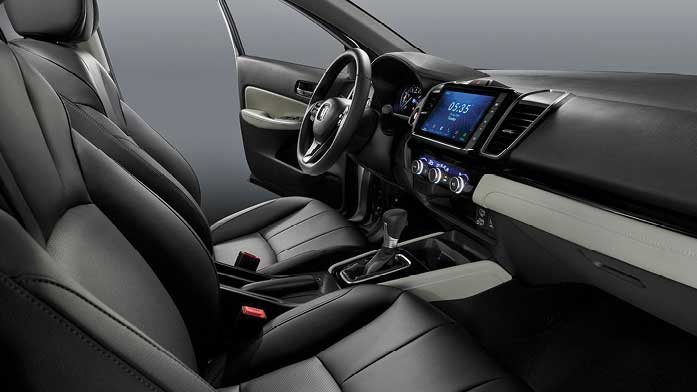HONDA CITY
IMPRESSIVE CONTENDER
Mat Ranasinghe takes a ride in Honda’s new City and enjoys a sedan in a world that loves crossovers
The City was introduced in 1981 as a subcompact three-door hatchback and two-door convertible. Being designed as a city car, Honda innovatively offered it with an optional Motocompo 50 cc scooter that could be folded and tucked neatly into the City’s boot.
However, it didn’t meet Japan’s strict Kei car criteria – unlike the N360 (a compact vehicle that Honda produced between 1967 and 1970). In 1996, the City made its debut as a sedan and remained so until the 2016 City hatchback (Gienia).
Don’t be surprised if you’ve never heard of the Gienia – that’s because it wasn’t very successful. With the present generation, Honda has revived the City hatchback to be sold alongside the sedan.
The new City has been designed with a more discerning buyer in mind. That’s because Honda has significantly stepped up its use of technology and safety features – almost to a level that matches the higher tier Civic. Impressive for a car based on Honda’s global small car platform!
Its front is a clear evolutionary step above the sixth generation. The redesigned headlamps with full LED lighting and sculpted crystal rock formation style elements undoubtably improve its appearance.
These headlamps are connected by a chrome grille (in black on the RS) with a less pronounced under-bite than on the Jazz/Fit. Even the tail lamps have a curved LED strip with defining arrow elements at the ends. We can’t help thinking we’ve seen these tail lamps somewhere, perhaps on a German competitor whose name begins with B?
The seventh generation is 53 mm wider and 109 mm longer than the model it replaces – once again, bringing it closer to the Civic.

Its side profile has a strong shoulder line that’s defined by a distinct sharp crease running along the entire side and joining the headlamps to the tail lamps. This crease is said to represent the sharp edge of a Japanese katana sword – but we feel it’s more a marketing gimmick.
The redesigned interior has better passenger legroom especially at the rear. Its instrument cluster includes a digital driver’s display on the higher end models plus an eight inch Android Auto/Apple CarPlay entertainment system.
And the RS model is equipped with paddle shifters to provide more control. Seats on the RS have bolstered support and are trimmed in a suede-leather combination. Honda’s ULTRA seats with customisable layouts for extra loading are included.
Safety features include dual front and optional side air bags, a lane watch camera for the passenger side and the Honda Sensing Suite, as well as lane keeping assist, adaptive cruise control, collision mitigation braking and road departure mitigation.
Certain markets are provided with a Honda connect app that allows remote starting/cooling, door locking/unlocking, fuel information access and vehicle tracking. Where have we seen that before? Perhaps the three-pointed star!
Regardless, it is impressive for this class! Speaking of which, class competitors include Toyota’s Vios and Nissan’s Almera. It would not be fair to include the Germans as the prices don’t compare.
We drove the more mundane variant, which is the 1.5-litre DOHC (dual overhead camshaft), which moved the City along nicely. It’s no rocket ship – with only 119 bhp and 145 Nm on hand… but it is a city car, after all. The only letdown on the drive line is the CVT transmission; so we would go for the manual although trying to sell a used one will be hard.
Engine choices vary based on geographical location. For example, we would have loved to get behind the wheel of the ‘Thai-spec’ 1-litre turbo petrol, which returns eco-car levels of economy. The Indian market gets a diesel with torque of 245 Nm – which that demographic obviously demands – while the rest of the world is weening off Rudolf’s fuel!
We won’t hesitate to recommend the City as a finalist in your search for a compact sedan. It’s priced competitively, built reasonably well and economical – especially if you opt for the 1-litre, e:HEV or diesel. And it’s roomy enough for a family with children.
HONDA CITY AT A GLANCE
MODEL
A seventh generation Honda City or sedan in its fifth generation. The City, initially introduced as a subcompact hatchback, has grown to become a regular family sedan with its improved use of space – even though the wheelbase remains the same.
ENGINES
1-litre VTEC turbo, 1.5-litre i-VTEC and 1.5-litre e:HEV hybrid in petrol versions with a 1.5-litre i-DTEC turbo diesel option.
FUEL
On petrol versions, the 1-litre turbo returns 25 km/litre, the 1.5-litre DOHC does 17.5 km/litre and the RS hybrid (e:HEV) manages 26.3 km/litre while the diesel 1.5-litre does 24 km/litre.
POWER
121 bhp on the 1-litre, 119 bhp on the 1.5-litre petrol, 108 bhp on the 1.5-litre hybrid and 99 bhp on the 1.5-litre diesel.
TRANSMISSIONS
1.5-litre petrol and diesel have a choice of six-speed manual or CVT while the others have only the CVT (hybrid e-CVT) complete with annoying wailing on hard acceleration.
DRIVE
Front-wheel drive.
VERDICT
The City is worth considering if a compact sedan is what you’re after. It has all the safety features and technology that a modern offering should have… plus Honda’s bulletproof reliability behind it.

